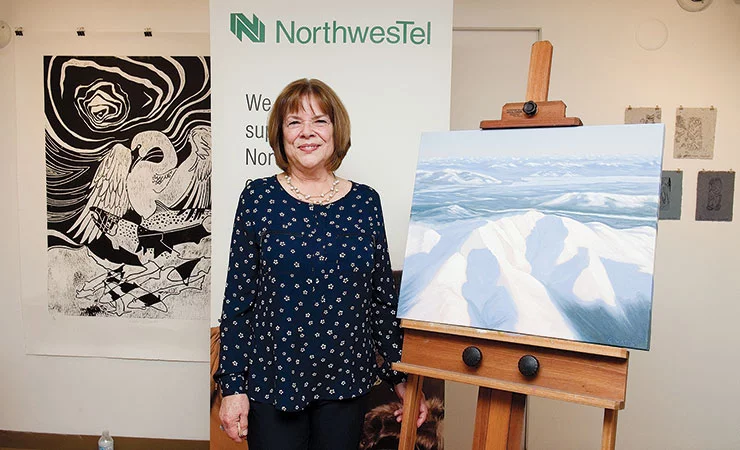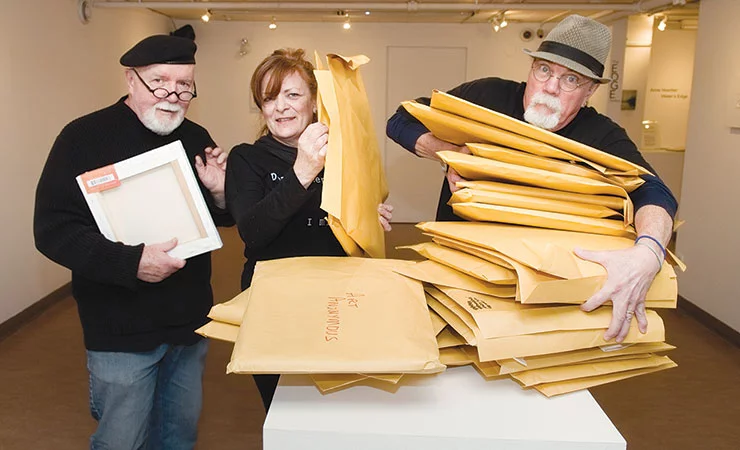In Northwest Revisited, John Boivin finds a new lyricism in his brushwork. He also makes a personal and shared connection with a little known facet of the history of Yukon art.
I figure that culture is partly art that talks to other art. By that, I mean artwork that speaks to work by other artists.
There’s a way we can stand on each other’s shoulders and build a web of relationships between our works … that’s part of what’s meant by the word “culture”.
John Boivin found a small black volume of poems and drawings called Northwest in a used book store in Vancouver. The book was written and published in Whitehorse 65 years ago. Charles Norman wrote the poems and William Barnett added drawings to the book.
The two men were American soldiers who were in the Yukon for a few years to help build the Alaska Highway.
It’s interesting to see an early response to the Yukon landscape. This urge to document the scenic North remains in much of the art that’s made here today.
Boivin wrote a lovely, accessible essay about how this book inspired him. It is available at the show. I strongly recommend reading it, as well as seeing the paintings.
There are two main kinds of paintings in the show: in one group of work, Boivin took Barnett’s drawings and painstakingly walked around the clay cliffs until he found Barnett’s original vantage point. Then, he sat down and painted there, in pencil and acrylic wash.
It’s easy to imagine that gesture as a kind of time travel, a way of for Boivin to make contact with the man who drew there 65 years ago.
There’s a pleasant solitude to painting the landscape en plain air — the land keeps you company. But to sit shoulder-to-shoulder, or perhaps in the very same spot, as someone else who created the same works more than half a century ago is an idea that gives me goose bumps.
Thankfully, Boivin allows us to take part in this time-traveling journey.
Paintings with a wide range of Yukon landscapes fill the rest of the show. The titles are more lyrical than what we’ve seen on Boivin’s work in the past. That’s because they’re lines taken from Norman’s poetry.
Boivin rides that lyricism into increasing confidence with his medium.
In The Flowing Lowlands Flood the Hills, green cradles Grey Mountain’s grey stone arcs. The movement continues down the piece, flowing over the foothills before breaking up like a wave into the Riverdale bridge and other little buildings.
Clay cliffs shear off down to the river in parallel brushstrokes in The Hills March over the Continent and Spill Bright Rivers to the Sea. The banks are sandwiched between blue sky and blue in the river. The hills’ rhythm is echoed in Boivin’s free brushstrokes in his trees.
Boivin’s paintings include scenes from all four seasons, as well as his signature forest scenes with groupings of tree trunks and large collections of vertical lines, mottled with light and the markings of bark. These markings are loose enough to keep freshness, but precise enough to clearly say birch or poplar.
His four-foot square canvas, This is an Outpost of the Land, depicts rocks, water and a Tom Thomson-style tree, with bare mountains in the distance, some snow-covered.
The Firs Stood with their Skirts in Snow depicts a heavily laden tree practically concealed in its burden of snow. Through blue-glazed globules we can glimpse dark branches.
In this piece, and in some of the tree-trunk paintings, sometimes he’s added a shadow to a tree trunk or branch behind snow after the foreground snow has already been painted. One more foreground stroke, to layer foreground snow back over that background dark, would more readily create the illusion of depth in the paint.
Overall, it’s a strong show that should not be missed, and a thoughtful look at the Yukon tradition of landscape painting.
We don’t just do it for tourists — we’re all still trying to get a grip on what the landscape here does to us.
Northwest Revisited continues at Arts Underground until June 23.


